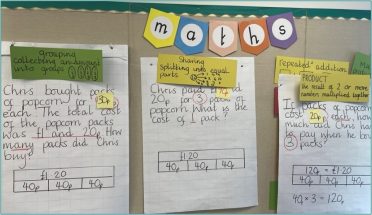Deepening understanding of part whole relationships – multiplication and division
Pupil independence and deepening understanding in KS2 maths
At this large primary school, as part of an annual package of support, the maths subject leader and Year 3 teaching team worked alongside their teaching and learning adviser with a focus on developing pupil independence and deepening understanding in KS2 maths.
Detailed planning workshops
A series of detailed planning workshops deepened teacher subject knowledge over time and empowered the team to create clear teaching sequences of modelling, combining concrete, pictorial and abstract (CPA) approaches.
Working walls
As part of this approach, working walls are now being used effectively to enable children to make connections between teacher modelling and independent rehearsal and practice, allowing understanding to deepen. Vocabulary is now being used more accurately and consistently by children, allowing them to reason and solve problems across the maths national curriculum.
Further reading:
4 ways to make your maths working wall work

Ongoing professional development to deepen understanding in KS1 maths


Barley and Barkway (VA), Church of England, First Schools Federation
Pupil independence & deepening understanding in KS1 maths
A key priority for the maths subject lead at this small first school was to deepen understanding using the Concrete, Pictorial, Abstract (CPA) approach and to develop pupil’s independent recording, reducing over-reliance on worksheets.
In-class professional development – subitising and part whole models
Through joint working in the Year 1 classroom, the maths subject leader and teaching and learning adviser found out more about how children were thinking, seeing number and subitising using familiar patterns. Interacting with the children provided opportunity to be playful with regrouping objects; connecting this to a familiar part whole model which was represented on the working wall.
Deepening children’s understanding over time
Between adviser visits, teacher modelling and continued playful exploration enabled all children to represent their thinking in a meaningful way. The teacher was excited to share evidence of children’s deepening understanding of early number and particularly how this enabled a child new to the country, with limited English, to show their thinking and be successful.
Further reading:
Year 1 Can’t Record, Can They?
What do we mean by ‘pictorial’ in the CPA approach?
Developing a maths curriculum for pupils with learning difficulties in a special school
Curriculum design and maths national curriculum progression
From working with their teaching and learning adviser, two special schools have been adapting the maths national curriculum to meet the needs of their pupils with learning difficulties. Through this collaboration, the schools now have a clear progression grounded in small steps through each area of maths.
Professional development for teachers
A combination of in-school professional development and HFL Education maths training has supported teachers to deepen their understanding of early maths concepts and how to adapt the ESSENTIALmaths primary resources. Teachers feel more confident in delivering appropriate learning to meet pupil's needs.
Personalising the curriculum to learning needs
Identifying pupil starting points accurately was important so teachers are teaching the correct content and pupils can be successful. Diagnostic questions have been used to identify strengths and gaps. Analysing diagnostic question responses has helped the teachers to ensure that curriculum progression is more personalised to pupil's needs.
Further reading:
Developing the maths curriculum in special schools
The CPD has definitely been impactful, with staff gaining the knowledge to teach early maths. It has made us think about the depth of knowledge as a building block rather than accepting that if a child can count to 100, they understand about those numbers.
Deputy Headteacher, Southfield School reflecting on the impact training has had on staff.

